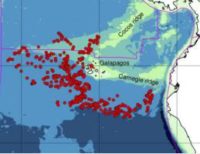
Credit: Princeton University
Scientists have identified a huge magma plume under the Galapagos archipelago using an array of floating robotic seismometers. In other news, the acronym writers have been working overtime. The robotic seismometers used in study have been named Mobile Earthquake Recording in Marine Areas by Independent Divers, or MERMAIDS.
The EuerkaAlert! reports: The researchers, from institutions in the United States, France, Ecuador and China, found that the volcanoes on Galápagos are fed by a source 1,200 miles (1,900 km) deep, via a narrow conduit that is bringing hot rock to the surface. Such “mantle plumes” were first proposed in 1971 by one of the fathers of plate tectonics, Princeton geophysicist W. Jason Morgan, but they have resisted attempts at detailed seismic imaging because they are found in the oceans, rarely near any seismic stations.
MERMAIDs drift passively, normally at a depth of 1,500 meters — about a mile below the sea surface — moving 2-3 miles per day. When one detects a possible incoming earthquake, it rises to the surface, usually within 95 minutes, to determine its position with GPS and transmit the seismic data.
By letting their nine robots float freely for two years, the scientists created an artificial network of oceanic seismometers that could fill in one of the blank areas on the global geologic map, where otherwise no seismic information is available.
The plume discovered under the Galapagos is the first major discovery accomplished using free-floating seismometers or as they are called, MERMAIDS.
The Galápagos Islands are a volcanic archipelago in the Pacific Ocean, about 600 miles (1,000 kilometers) off the coast of Ecuador.
